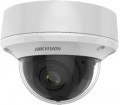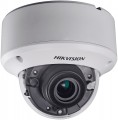Matrix size
The size of the matrix installed in the surveillance camera (diagonally).
In general, larger sensors (with the same resolution and sensor type) are considered more advanced: they get more light, which has a positive effect on image quality (especially in low light). On the other hand, increasing the size affects the cost of the entire device; and in some cases (for example, if the camera is not planned to be used in twilight and darkness), a relatively small sensor may be quite suitable.
As for specific dimensions, the most modest cameras in terms of this indicator have matrices of
1/4 "or less. Models with sensors of
1/3.8" - 1/3" and
1/2.9" - 1/2" are very popular, these values can be called average. And in advanced devices, diagonals and
more than 1/2 "(up to 1/1.7") are found.
Frame rate
The maximum frame rate in the video captured by the camera.
The higher the frame rate, the clearer the image, the less noticeable blurring when moving in the frame (especially fast). On the other hand, this indicator affects the amount of information recorded during shooting, as well as the cost of the camera itself. Therefore, it makes sense to specifically look for
a video surveillance camera with high-speed shooting(45 fps and higher) only if a clear recording of fast moving objects is important to you.
Recording 25/30 fps
The highest resolution at which the camera is capable of recording video at a frame rate of at least 25/30 fps. The parameter is specified for models that have high resolution shooting with a low frame rate (for example, 4K at 15 fps). It gives an understanding of the specific resolution at which video recording is supported with a frame rate of 25/30 fps, at which the picture is perceived smoother and details in dynamic scenes are better seen (if there are moving objects in the frame).
Aperture
Aperture of the lens installed in the camera.
Aperture characterizes the degree of attenuation of the light flux when passing from the front lens of the lens to the matrix. It is denoted as the ratio of the diameter of the active aperture of the lens to the focal length, while the size of the active aperture is designated as f and is taken as a unit — for example, f / 1.4 or f / 2.0. Moreover, the smaller the number in the designation, the higher the aperture (in our example, the second lens will be darker than the first). And for lenses with a variable focal length (see "Focal"), the actual aperture, usually, changes with a change in focal length; for such models, either the range of aperture values, or its maximum value, can be indicated.
By itself, this parameter characterizes, first of all, how light the image taken through the lens turns out, all other things being equal. High values are important, first of all, when shooting in low light conditions: a fast lens allows you to get a fairly high-quality image without increasing the sensitivity of the matrix, which is fraught with noise and “blurring” of the picture. On the other hand, the actual quality of camera operation (including in dark conditions) also depends on many other factors — the type and size of the matrix, signal processing features, etc. Therefore, aperture in most cases is more of a reference than a practically significant parameter.
Focal length
Focal length of the camera lens.
The focal length is such a distance from the lens to the matrix, at which a clear image is obtained on the matrix (when the lens is focused to infinity). The viewing angles of the lens primarily depend on this indicator (see below): the smaller it is, the wider the viewing angles and the smaller the objects in the frame (and vice versa). At the same time, it should be noted that the actual viewing angle is determined not only by the focal length, but also by the size of the matrix (see above). In fact, this means that with different sizes of matrices, lenses with the same focal length will have different working angles. Therefore, only cameras with the same matrix size can be compared with each other according to this indicator. Among CCTV cameras, lenses with a focal length of
2.8 mm,
3.6 mm,
4 mm and
6 mm are considered popular.
In models with a variable focal length (see above), in this case, the range from the minimum to the maximum distance is indicated. Also, using these data, you can derive the optical magnification factor of such a lens: for this, the maximum value must be divided by the maximum (for more details, see below).
Horizontal viewing angle
Horizontal viewing angle of the surveillance camera. For models with a variable value, the maximum value is indicated, since it is the width of the image that is important, and when zooming in, the zoom factor is more important than the angle. This paragraph also indicates the general angle of view for models with a circular field of view – in particular, cameras with a fisheye lens (see above)
The wider the viewing angle, the more space the camera captures and at the same time, the smaller the images of individual objects in the frame are obtained. Therefore, when choosing by this parameter, it is worth deciding what is more important – the ability to view a large scene or the visibility of small details in a relatively narrow field of view. Also note that with a wide field of view (100° or more), characteristic distortions can be observed at the edges of the frame, and the wider the angle, the more pronounced they are. This phenomenon can be eliminated by panoramic shooting (see "Design and features"), but this feature, in turn, complicates and increases the cost of the camera.
Optical zoom
Modern surveillance cameras can provide two types of magnification - optical and electronic. In the first case, the “approximation” of the image is carried out due to the operation of the lens; in the second, a separate area is selected on the matrix and the image from it is “stretched” across the entire frame, creating a magnification effect. Thus, optical zoom is more advanced: it allows you to use the entire sensor area even when zooming in.
Optical zoom is only available if the camera lens has a variable focal length (see “Focal”). And the degree of magnification will correspond to the ratio between the maximum and minimum focal length: for example, for a model with a range of 3 – 15 mm it will be 15/3 = 5x. Thus, we are not talking about how much the camera enlarges the “picture” relative to how it is visible to the naked eye, but about how much larger the image is at the maximum focal length than at the minimum.
The disadvantages of optical zoom systems are directly related to the disadvantages of variable focal length: the lenses are larger, more expensive and less reliable than with electronic ones. In addition, the capabilities of this operating format are limited:
too high magnifications would require too bulky and expensive optical systems. Therefore, manufacturers often use a compromise option, supplementing optical magnification with electronic one: the first option is used at low magnifications, the secon
...d is turned on when the capabilities of the optics are exhausted.Power consumption
The power consumed by CCTV cameras during operation. Knowing the indicator of energy consumption, you can, for example, calculate the battery life of equipment from an uninterruptible power supply or choose a suitable “uninterruptible power supply”. Also, with the support of PoE technology, it is worth considering the power consumption when choosing a PoE switch or PoE adapter.

